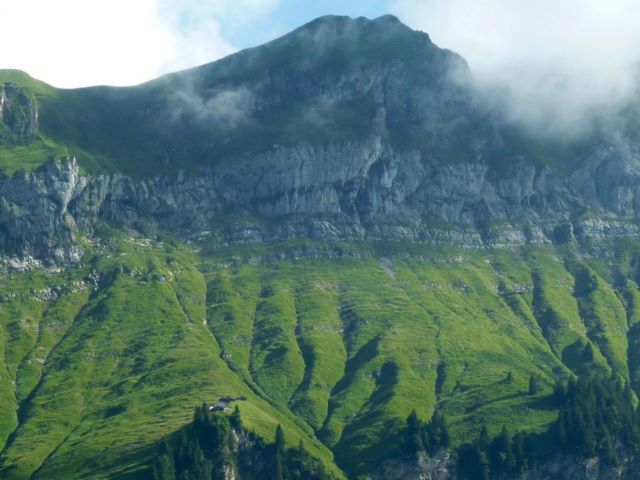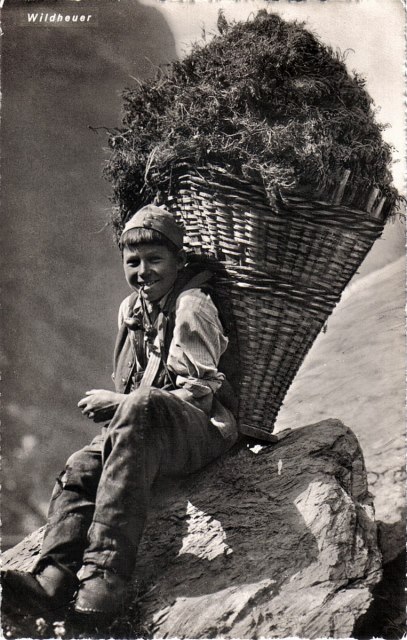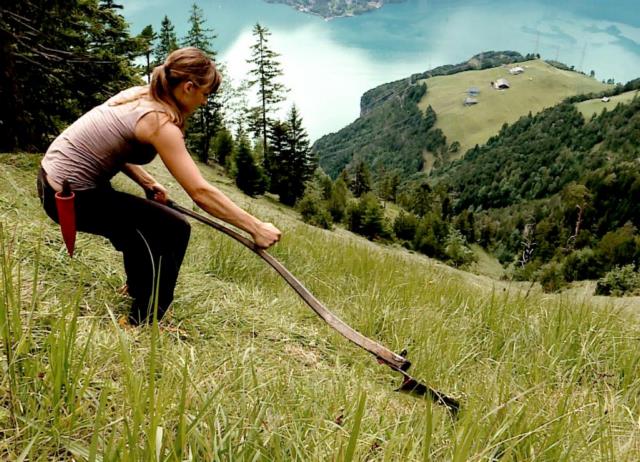Mo., Nov. 1st 2021

Wild haymaking is a curious remnant of past centuries. In the past, farmers in alpine regions would venture to the highest and steepest meadows in order to harvest hay. Needless to say, this was a time when all cows were grass-fed during summers, and hay-fed during winter months. This organic food is very nutritious and is ideal for cows that have to live in a barn during winter.

A 1940’s photograph of a farmer practicing wild haymaking.
Wild haymaking is 100% SwissWhen you thought that wild haymaking is just cutting grass on a hillside, think again. This practice is a discipline of its own, and the organic hay is a critical ingredient for the healthy life of the Swiss throughout the year. Organic hay is the first step to producing grass-fed milk, which in turn is the basis for real organic food. In fact, hay harvested from alpine meadows is the root of traditional Swiss foods such as cheese and dry meat.
The process of wild haymaking takes place over the course of several months. Farmers would initiate the first preparations as soon as the winter’s snow has melted. They would go up to higher altitudes where they would set up the access paths.
Since some surfaces might have been altered during winter, farmers would level out any eroded patches. Further, they would collect rocks, branches, or other debris which snow and avalanches have brought down the mountainside. As it turns out, spring cleaning is also taking place in the mountains.
Fast forward to the month of July when the farmers would return to the high alpine meadows. At this point, they would cut the tall grass in every nook and cranny of their pastures. Their tool of choice is the old-fashioned scythe. Often portrayed as the tool of death in cartoons, scythes are actually a legitimate tool for the Swiss culture of wild haymaking.
As it turns out, a scythe is rather complex to manipulate. Some say it takes a lifetime to learn how to use this tool efficiently. Compared to mechanical cutting tools which tend to be bulky and limited by the size of their fuel tank, scythes are lightweight and durable. It comes as no surprise that this tool has been the preference for cutting grasses, herbs, and shrubs on hard-to-reach meadows…

Due to the steep elevations, the safety of farmers is always an issue. But instead of installing high-tech gear, Swiss farmers still use traditional methods: mountaineering shoes, climbing irons, and ropes. (The mountaineering shoes are an upgrade to the more traditional wooden shoes with makeshift spikes.)
In late summer, it is time to harvest the hay. By now, the organically grown grass has dried in the sun and is ready to get picked. Again, farmers prefer a hand-held tool that is tried and true over modern tools. By using big wooden rakes, they would now gather the hay on large nets.
Each hay net is then tied up and weighs about 60 kilograms. In the local Swiss-German dialect, such a net is called Pinggel. For comparison, 60 kilograms is the weight of no less than nine bowling balls or fifteen alphorns.The point is: a Pinggel is pretty heavy and has the potential of seriously injuring someone.
No wonder that transportation poses the highest risk of all the steps involved in wild haymaking. Now, rolling this ball of hay down the mountain would obviously be very dangerous. Instead, farmers would transport them to the valley using a system of zip lines. Alternatively, some farmers will airlift the hay using helicopters. The latter is the most efficient mode of transport, allowing them to move up to 1000 kilos of hay per minute.

Haymaking requires real Swiss food as fuelHandling the heavy hay at great heights requires a lot of energy and physical strength. This is why, a century ago, Swiss farmers identified the perfect diet based on organic food. A farmer’s meal traditionally consists of dried meat such as beef jerky, as well as sausages, bacon, cheese, and bread.
The traditional drink is a heavily sweetened black coffee spiked with a shot of liquor. This diet is emblematic of Swiss traditional food. It closes the cycle as the Swiss farmers eat products derived from the animals they are working to feed.
Harvested hay does not only feed the animals that in turn produce real food. This Swiss tradition also helps with avalanche prevention. If the pastures were left uncut, they would turn increasingly slippery with the autumn rain and might cause erosion in the spring.
The hay is ideal for nurturing biodiversity. While drying in the summer’s sun, it is a haven for bees, butterflies, or even critters. This is why this Swiss tradition is so important to maintain. A while ago, wild haymaking was nearly lost to new farming technologies, and to the lack of financial incentives. This is the reason why in 2013, the Canton of Uri launched a heritage initiative to save and maintain this century-old tradition.
If you find this Swiss tradition as interesting as we do, why not witnessing wild haymaking with your own eyes? It is a rewarding experience to gain an appreciation for the quality of hay that ultimately produces organic milk and healthy foods. Several regions in Switzerland above 1500 meters of altitude continue to practice the age-old tradition of wild haymaking:
And while you are visiting, why not explore some of the most amazing mountain peaks? We have the perfect suggestions for Swiss cable cars for peak hunters. If you prefer not to lift off, here is our listing of mountain railways in Switzerland.
